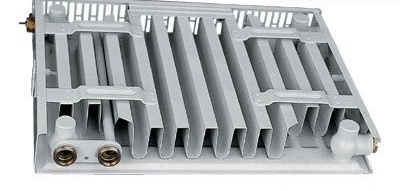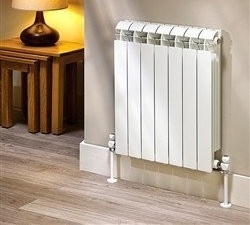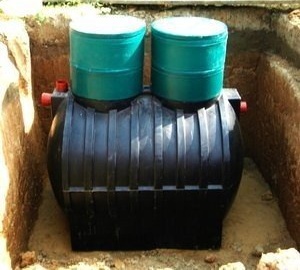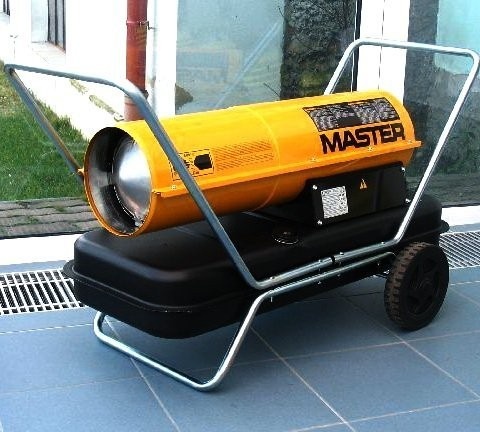Steel Radiators: Overview of Specifications and Selection Tips
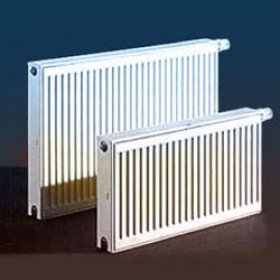
Heat in the house is the most important component of comfort and coziness. It would be a mistake to think that a comfortable room temperature depends entirely on the heating system. The type of radiators installed in the apartment is also very important. Among developers, panel steel radiators that have appeared not so long ago are very popular. They are recognized as the most widespread heating construction in the world, confidently crowding out traditional cast-iron batteries from the market. Steel appliances are diverse and have many advantages. How to choose such a system? Let's get it right.
Content
Where can I install such a battery?
Steel radiators can be installed in various systems, but for each there are certain nuances. Now we will consider them.
Autonomous heating systems
Steel appliances are great for stand-alone structures. House owners only need to monitor the pressure of the liquid in the system, it should not exceed 10-15 bar. In addition, attention should be paid to the quality of the coolant. Despite the fact that steel is relatively resistant to corrosion, radiators are not recommended to be exposed to prolonged exposure to aggressive environments. The manufacturer guarantees that, subject to the use of filters and timely regulation of pressure in the system, the devices will last at least 20 years.
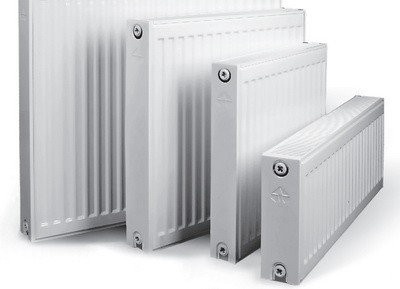
Steel devices can be used both in autonomous and in centralized heating systems. In the first they will last much longer
Central heating
For buildings connected to district heating, steel radiators are also suitable. The operating pressure of the devices is 10-15 bar. Given that the pressure in the system is usually not more than 6 bar, a certain margin of safety remains. The quality of the coolant in such a system is far from recommended. Water is often too hard with the addition of solid suspensions. All this leads to the gradual accumulation of deposits inside the devices and the abrasive destruction of steel devices. In the central heating system, they will be able to work for about 10 years.
Steel equipment can be installed in trade pavilions, industrial premises, warehouses and other structures with a closed heating system. The low cost of appliances allows you to equip spacious buildings with minimal cost. Steel devices can be installed in almost any room, but best of all they show their qualities in autonomous heating systems.
We suggest you also listen to the opinion of experts:
Design Features of Steel Radiators
Two types of steel radiators are available, differing in design. We will consider each of them in detail.
Option # 1 - panel devices
The devices are a kind of panel that is attached to the wall or directly to the floor. The design of such devices is quite simple. The panel is welded from two plates between which the coolant circulates. The width of the elements is 1.2-1.5 mm, stamped channels are present, the connection of parts is carried out using spot welding. Steel panel heating batteries are characterized by high ability to transfer heat and attractive appearance. Such equipment successfully combines the characteristics of sectional and convection radiators.
Among the advantages of panel devices include their wide range. On sale you can find devices of various configurations and sizes. In addition, the equipment differs in the type of connection to the pipe wiring:
- Lower. It suggests the possibility of mounting a thermostatic valve, on which a thermostat is installed, which controls the room temperature.
- Lateral. The most affordable option, making it possible to use the natural circulation of the coolant.
In addition, steel radiators equipped with two types of connections can be found on sale.
To increase heat transfer, radiators are equipped with several panels. Since the structure transfers heat only to the outer planes, additional plates in the form of the letter P are welded to the inner planes. Thus, it is possible to increase the heat transfer surface. Internal elements function according to the principle convector. Thus, convection heat accounts for 75%. The disadvantages of such devices include a lot of weight. For example, a three-panel radiator weighs almost as much as a cast-iron one. A large number of coolantlocated inside the device reduces the effectiveness of the temperature control. In addition, it is quite difficult to clean such a device from pollution.
Option # 2 - tubular devices
Devices are a system of lower and upper collectors interconnected by vertically arranged tubes. The latter may be a maximum of six rows. Such devices are recommended for use in houses of small number of storeys. Working pressure in tubular steel radiators is 8-10 atm. The wall thickness of the devices is 1.3-1.5 mm. Such batteries are available in sectional and non-sectional lengths, the maximum length is 3 m. The equipment is hygienic, is well washed and has a high level of safety. Some models are polymer coated on the inside, which extends their life.

Steel tubular radiators are characterized by the presence of an upper and lower manifold system, interconnected by tubes. They can be produced in sectional and non-sectional versions.
The advantages of tubular devices include:
- High working pressure, designed for possible water hammer. However, it is best to use tubular devices in autonomous heating systems, where the coolant pressure is relatively small.
- The simplicity of the design, which implies the absence of difficulties in the manufacture of the device and, accordingly, their low cost.
- Design features of devices, such as welding sections without gaskets, provide high resistance to mechanical damage.
- Easy installation. Various methods of connection make it possible to use steel tubular devices practically anywhere.Most models are equipped with fasteners and communication parts, which allows them to be installed quickly and reliably.
- Universality. The devices are compatible, practically, with any materials used for fastening.
- The possibility of sectional additions for sectional models, which involves reducing or increasing the number of sections at the request of the owner.
- A variety of accommodation options. Devices can be installed horizontally, at an angle or vertically.
A number of models, the so-called design radiators, offer special opportunities for interior planning. These are devices manufactured in the form of railings for stairs, frames for mirrors, interior partitions, etc.
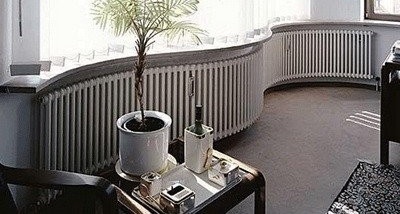
Sectional tubular radiators may have a different number of sections. Their number is determined by the landlord
Why would you not want such a radiator?
It should be noted that of all types of heating equipment, it is steel structures that are most susceptible to corrosion, which significantly affects their life. Laboratory studies have shown that over the course of a year a steel battery loses about 0.1 mm of its thickness due to corrosion processes. Thus, a steel sheet 1.2 mm thick, even under the most favorable conditions, can withstand no more than ten years of operation, which cannot be considered a high rate.
In addition, the joints are made by spot welding, which makes these areas even more susceptible to corrosion. Air entering the system significantly speeds up this process. This is another reason why it is not recommended to install steel heating radiators in apartment buildings with a centralized heating system, where the water is drained after the end of the heating season. It should be borne in mind that panel-type devices are least resistant to water hammer. This is because the channels have a small passage size. At high pressure, such a device inflates and can burst, especially at the joints and seams.
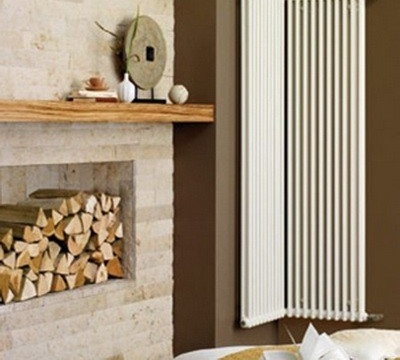
Steel devices can also be produced in the form of so-called design radiators. Such devices fit perfectly into the interior and attract unusual appearance
Strength test example:
How to choose the option that suits you?
What characteristics of steel heating radiators, in addition to their power, should be followed when choosing?
The size of the device should be selected based on the parameters and the area of the heated room. Devices vary in depth (type 33, 22, 11), in length (from 3000 to 400 mm) and in height (from 900 to 300 mm). Each size is characterized by its own heat transfer parameters. The larger it is, the correspondingly, such a radiator can heat a large area. The numbers 33, 22 and 11, indicating the type of radiator, indicate the number of so-called "accordions" or U-shaped plates mounted on the equipment. One plate is designated 11, two - 22 and three - 33.
These radiators, as a rule, are available in two versions: with side or bottom connection. The first option is considered standard. He is also the most common. This is due to the fact that devices with a lower connection are much more expensive, which is associated with the design features of the equipment. Such devices are conventional radiators with lateral connection, equipped with leads lowered to the bottom of the device. This addition complicates the design and requires additional components, which affects the cost of equipment.
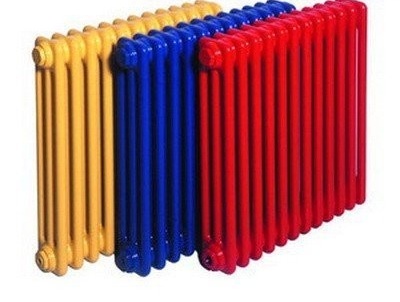
Steel equipment is most often painted white or its shades. However, if desired, you can pick up devices of various colors
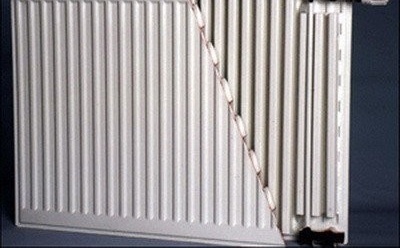
Panel devices are least resistant to water hammer. The channels stamped inside them are quite narrow and with an increase in the pressure of the coolant they can simply burst
It is worth paying attention to the manufacturer. It should be noted that the methodology for manufacturing devices at all companies is almost the same. But the cost of devices varies greatly. It is determined based on the design, brand and size of the device. Often, you can purchase a high-quality domestic device and not overpay for a foreign brand. When choosing the best option, such nuances are also taken into account:
- The device must be equipped with a Maevsky crane so that it can be, if necessary bleed air. It is also good that the device has a tap that shuts off the flow of coolant, which is necessary in case of emergency.
- The deeper and lower it is supposed to position the radiator, the more evenly the room will warm up.
- The most practical batteries are thermostats, manual or automatic.
- The device installed under the window should occupy at least 50-75% of the width of the window opening.
Steel radiators are among the most popular heating appliances. They are distinguished by their modern stylish appearance, high heat dissipation, affordable cost and are widely used in country houses, apartments, offices and shops. Experts do not recommend installing the devices in rooms with high humidity and carefully installing them in apartments with central heating. But in autonomous heating systems, steel appliances serve for a long time and flawlessly.
